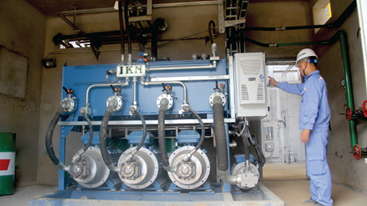Saturday, 27/07/2024 | 07:44 GMT+7
The use of conventional energy such as fuel-wood and charcoal in rural and mountainous areas in our country has reduced the forest area and increased the amount of CO2 emission. Meanwhile, modern energies like electricity, gasoline, petroleum are becoming more and more costly, unaffordable for people in remote areas. A positive solution is to use biogas – an in-place and cheap energy source for farmers.

The term ‘biogas’ refers to biogenic gas produced from the decomposition process of human and animal waste in the absence of oxygen. Microorganisms cause the waste to ferment, creating gas, in which methane accounts for 70%, which is then used as fuel for firing and in internal combustion engines.
After years of researching and analyzing Biogas cellar, many
companies have successfully produced Biogas spherical tank made of composite
material, with absolute advantage over traditional brick biogas tank. This
biogas tank is quite easy to install, occupies a smaller area and can be
installed underground. Regarding economic efficiency, for a rural household
using electricity for lighting, raising from 10 to 15 pigs regularly will
provide enough raw materials to produce biogas used for cooking and lighting
purpose in a whole year. According to a research in
Nowadays, more and more people have started using biogas tanks made from composite material. This new type of tank has many advantages of high durability, high productivity and having the ability to verify and fix tightness right from installation. The tank will not be broken, cracked or have gas leaking even under unfavorable conditions such as weak foundation, subsidence, cracking, etc; and will not be corroded by acids. Its high productivity comes from its absolute tightness and ability to withstand high pressure. The tank has a plus capability of scum-cleaning, making it able to reach 100% potential in fermentation of anaerobic metabolism. Little time and effort is needed to install, only after 2 - 3 hours of installation the tank is ready for using.
Moreover, it is possible to install additional equipment such as lamps, water heaters using biogas, heaters for pigs, electricity generators using gas… to exploit gas generating potential. Composite biogas tank provides a cheaper, safer, more durable and more efficient way to produce energy and can be linked with domestic septic tank.
Meanwhile, biogas tank made from brick is very likely to have unrepairable cracks, subsidence. The risk of breakdown increases proportionally with tank size. Besides, the inside concrete surface is gradually eaten by acids, which decreases tank’s strength and may lead to gas leaking. Building a tank requires large volume of materials, much longer time and a broad constructional area, while tank’s quality still heavily depends on workers’ skillfulness. The tank also lacks the capacity to adjust gas pressure automatically or scum self-cleaning. Gas pressure only reaches 0.5 metres of water column. Excessive gas amount must be manually let out and a protective valve is required.
Moreover, after being used for a long time, residue and scum will be accumulated inside the tank, significantly reducing the amount of gas until removal of scum and residue. Brick biogas cannot be moved but only be demolished. Due to weak gas pressure, the installation of additional equipments and accessories is impossible.

"Despite higher installation cost, composite biogas
tank has proved to be more economically efficient and environment-friendly.
Many households have realized its benefits and started using", said Mr.
Thai, Director of Anh Thai Manufacturing and Commercial Ltd Company, specializing
in producing biogas tank made from composite materials in
Mrs. Cu, having a VAC model at her house in Vu Thu, Thai Binh, praises the new biogas model for its convenience and cost efficiency in cooking and lighting, and especially in keeping the environment clean. Before, she planned to build biogas tank from brick but had to cancel due to her low-lying old barn. “Now after having installed biogas tank made from composite material, not only gas and electricity costs can be reduced but farming also becomes easier, by-product can be used to fertilize vegetables as well as feed fish. I could save up to 1 million dong every month”, said Mrs. Cu.
Hopefully in the near future, the biogas tank model made from composite material will become more popular. This model should be further expanded in order to reduce environmental pollution and help save energy.
By Nguyen An



.jpg?w=367&h=206&mode=crop)




.jpg?w=367&h=206&mode=crop) Notice for Contracts award for Support to Industrial Enterprises for Energy Audits and Preparation of Feasibility Studies (Package No. C2.2.4)
04/06/2024
Notice for Contracts award for Support to Industrial Enterprises for Energy Audits and Preparation of Feasibility Studies (Package No. C2.2.4)
04/06/2024
 Training Courses for Energy Managers and Energy Auditors
Training Courses for Energy Managers and Energy Auditors
 Vietnam Energy Outlook Report – Pathway to Net Zero
Vietnam Energy Outlook Report – Pathway to Net Zero
 Long Son Cement saves 30% of electricity consumption thanks to heat recovery
Long Son Cement saves 30% of electricity consumption thanks to heat recovery
 Expression of Interest: C2.1.15: Development of Energy-Efficient Technology Catalogs for the Industrial Sector
Expression of Interest: C2.1.15: Development of Energy-Efficient Technology Catalogs for the Industrial Sector
 Optimizing Compressed Air Systems for Southern Industrial Enterprises
Optimizing Compressed Air Systems for Southern Industrial Enterprises
 The Ministry of Industry and Trade Review the Energy Efficiency and Conservation activities in Lao Cai.
The Ministry of Industry and Trade Review the Energy Efficiency and Conservation activities in Lao Cai.
 EOI Extension: C2.2.2: Review and update for current EE benchmarking for 2 sub-industrial sectors
EOI Extension: C2.2.2: Review and update for current EE benchmarking for 2 sub-industrial sectors